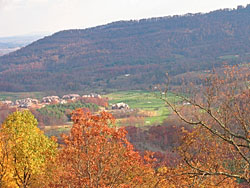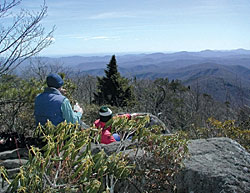
photo by Jodi Ford
The new view: Looking down from the Walnut Cove overlook, Parkway visitors now see the mansions and fairways of a gated community, the Cliffs at Walnut Cove.
|
It’s an unseasonably warm November afternoon along the Blue Ridge Parkway south of Asheville, and car after car slows to a halt at the Walnut Cove overlook (milepost 396.4). The views here open to the south and east, across the Blue Ridge proper and on to a rumpled horizon, ridge piled on dusky ridge — exactly the sort of breathtaking vista the Parkway is famous for.
After a reluctant leaf season, Mother Nature has finally delivering the goods. Hickories glow an eye-searing yellow, maples sizzle fiery red, and sassafras blares bright orange. This is it — the big show — and almost without exception, visitors clutch digital cameras in hopes of preserving the moment.
Among the assembled rubberneckers are Asheville residents Margaret Roberts and her husband and son. Leaf-spotting along the Parkway is a seasonal rite for Roberts; the Virginia native says she’s traveled the scenic highway each fall for nearly 60 years. Childhood trips down the Parkway with her family were wonderful, remembers Roberts.
“You almost felt like you were going out West back then, into the wilderness. And now this.” She points toward the valley floor, where the fall panorama is ruptured by the vivid green of a golf course ringed by large, imposing homes.
“I think what offends me is that they make no effort to blend the architecture with the landscape,” says Roberts. “I suppose some people see this as progress; I sure don’t.”
The license plates on the cars parked or idling at the overlook — Georgia, Pennsylvania, North Carolina, Florida — testify to the Parkway’s broad appeal. More and more, however, both casual visitors and longtime Parkway fans are sounding a chorus of worry about the scenic roadway’s future.
“I’d say it’s the biggest challenge we face,” says National Park Service spokesman Phil Noblitt, talking about the escalating loss of Parkway vistas.
The color of money
Some Parkway overlooks offer seemingly unlimited views. Yet the federally owned corridor through which the 469-mile-long roadway runs averages just 800 to 1,200 feet in width, and it’s narrower in many places. Except where the Parkway cuts through other protected land — such as national forests or state parks — its buffer is generally limited to the original federal acquisitions (most dating back to the 1930s, when the park was created). Beyond a modest “scenic easement” — a founding provision aimed at staving off the blight of billboards and hot-dog stands along the corridor — the National Park Service, which administers the roadway, has no control over the property beyond its borders.
“We’ve always had the notion that the Blue Ridge Parkway would be a sort of museum of the American countryside,” says Noblitt. But it’s hardly a tidy diorama; the elements around it are always changing — and never faster than during the past decade. As mountain land has become more desirable for residential development, as farms have been sold and longtime family holdings parceled out, threats to favorite Parkway beauty spots have multiplied.
The National Park Service has limited funds for land acquisition. The bulk of the Parkway’s $14 million annual budget goes toward salaries, operations and tackling a swelling backlog of maintenance tasks. And the lack of users’ fees means there are no direct revenues to help protect and enhance the linear park.

photo courtesy
Southern Appalachian Highlands Conservancy I can see clearly now: Hikers sit atop Walker’s Knob in the Montreat Wilderness, where the Southern Appalachian Highlands Conservancy has helped preserve 2,500 acres.
|
In the absence of federal funding for scenic preservation, private-sector partners have become indispensable, says Noblitt. One of these, the Raleigh-based Conservation Trust for North Carolina, has preserved more than 28,000 acres along the Parkway since 1992. Another nonprofit, the Asheville-based Southern Appalachian Highlands Conservancy, is working with owners of property adjacent to the Parkway to protect the park’s borders and views via conservation easements and outright donations. Landowners selling conservation easements retain title to their property but give up the right to develop it; they also get a federal tax deduction and a substantial state tax credit. A designated entity (usually a nonprofit conservation organization or a government agency) is responsible for enforcing the restrictions.
Last month, the Conservancy announced a deal with the Woodfin Sanitary Water and Sewer District: a $4.1 million conservation easement covering 720 acres of the Woodfin watershed (which includes three miles of Parkway frontage). The water district also agreed to donate an 1,140-acre easement within the watershed. In an earlier transaction, the Conservancy paid $3.8 million for a conservation easement on 2,463 acres in the Black Mountains owned by the Mountain Retreat Association of Montreat. Both transactions were made possible through grants from the N.C. Clean Water Management Trust Fund; created by the General Assembly in 1996, the fund supports projects that maintain or improve surface-water quality in the state.
Yet even with the significant tax advantages conservation easements confer, their success as a tool for preserving views depends to some degree on a landowner’s willingness to embrace public-mindedness over maximum profit — a decision that may become harder for property owners to justify as the value of mountain land continues to rise.
In the case of the Montreat property (which is visible from the Parkway at Craggy Gardens), the association sold the easement to the Conservancy at roughly half its market price. “It was a really good deal for everybody,” says Carl Silverstein, the Conservancy’s executive director. “Whenever we can, we try to work with landowners that are willing to sell for less than the market value.”
The business of scenery
But landowners aren’t the only ones with money on their minds. Parkway visitation, says Noblitt, is a key component of Western North Carolina’s economic engine. A 2002 visitor survey commissioned by the Park Service concluded that travelers on the 252 miles of Parkway that wind through North Carolina spent an average of $170 per day. According to the Park Service, that adds up to roughly $1.5 billion in direct and indirect annual economic impact on the region. The survey, conducted by UNCA and Warren Wilson College, also found that visitors would be less inclined to make the trip if the vistas became degraded.
But one person’s eyesore may be another person’s stunning mountain vista. “Somebody from New York City would probably stand up at the Walnut Cove overlook and see the view as rural, where someone from the local community would be more aware of the changes,” notes Blue Ridge Parkway landscape architect David Anderson. “It’s all what you’re used to.”
The National Park Service, says Anderson, welcomes — but cannot demand — a place at the table when neighboring developments are in the planning stages. For example, the agency worked with local developer Biltmore Farms on The Ramble, a 400-home project that backs up to the Parkway between Bent Creek and Biltmore Forest, south of Asheville. The discussions, he reports, concerned setbacks and limiting building heights.
As for The Cliffs at Walnut Cove, the 1,300-acre development that’s visible from the Walnut Cove overlook, Jamie Prince, communications director for The Cliffs Communities Inc., says her company did take measures to lessen the environmental impacts there, including a conservation easement along streams that pass through the Jack Nicklaus Signature golf course. “We have dealt with the Blue Ridge Parkway and the [U.S.] Forest Service,” Prince said. “We touched base with them as soon as the development was announced in 2002.”
As Anderson sees it, clearing ridge tops to build single-family homes is more damaging to the scenery than subdivisions built down below. “I think someone would look at these ‘trophy houses’ built up on the ridge tops as worse, visually speaking, than a golf-course development like The Cliffs at Walnut Cove, down in the valley,” he says.
Another result of development edging ever nearer to the Parkway, says Anderson, is the growing instance of what he calls “trespassing” — private incursions onto public land. These, he says, can be as simple as homeowners piling grass clippings or parking vehicles on park property, or as intrusive as illegally “manicuring” a portion of the Parkway corridor.
The common good
J. Scott Graham, a photographer based in Johnson City, Tenn., has been capturing Parkway views for the past 15 years. During most of that time, he says, air-quality problems were the primary culprit in diminished Parkway vistas — especially around Asheville, where pollution often reduces visibility. But now, notes Graham, the mantle has passed to commercial and residential development.
“We can clean up the air, but once the views are gone, we can never replace them. We’re losing a scenic frontier. It’s a tragedy, but there are not a lot of solutions.”
To devotees like Graham, the Parkway is as much an aspiration as a landmark — a chance for a broad segment of the public to easily experience the awe and rejuvenation of the Appalachian high country. But with “America’s favorite drive” increasingly at the mercy of the changes around it, Graham believes developers need to temper private ambition with an acknowledgement of the Parkway’s value to the national imagination.
“I have my own business,” notes Graham. “I’m a free-market economist; I’m all for private-property rights. But there should at least be a discussion of the weight that these decisions, these changes to the landscape, are having on the common good.”
[Freelance writer Kent Priestley is based in Asheville.]



Before you comment
The comments section is here to provide a platform for civil dialogue on the issues we face together as a local community. Xpress is committed to offering this platform for all voices, but when the tone of the discussion gets nasty or strays off topic, we believe many people choose not to participate. Xpress editors are determined to moderate comments to ensure a constructive interchange is maintained. All comments judged not to be in keeping with the spirit of civil discourse will be removed and repeat violators will be banned. See here for our terms of service. Thank you for being part of this effort to promote respectful discussion.